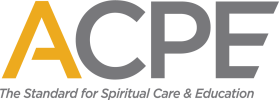ACPE related terms may be found by clicking here.
Academic Resources: Academic resources shall be reflective of the program’s curriculum and consistent with the program’s expectations for student learning. Such resources include, but are not limited to: relevant and current texts and periodicals; research journals and databases; standard works of reference; multi-media and/or electronic resources.
Appreciative Inquiry: “Appreciative Inquiry (AI) is a group process that inquires into, identifies and further develops the best of “what is” in organizations in order to create a better future. Often used in the organization development field as an approach to large-scale change, it is a means for addressing issues, challenges, changes and concerns of an organization in ways that builds on the successful, effective and energizing experiences of its members. Underlying AI is a belief that the questions we ask are critical to the world we create.” (Preskill & Catsambas, 2006, p2) Appreciative Inquiry will be the lens through which conversations about accreditation in centers takes place.
Clinical Method of Learning: An educational model that engages the student in reflection on and inquiry about the actual practice of spiritual caregiving.
Culturally Responsive: Culturally responsive pedagogy is a student-centered approach to teaching in which the students’ unique cultural strengths are identified and nurtured to promote student achievement and a sense of well-being about the student’s cultural place in the world. Taken from the work of Dr. Matthew Lynch
Curriculum: For ACPE, curriculum has two primary meanings. First, historically, curriculum is the learning that evolves and emerges from human interaction and experience. The second meaning of curriculum refers to the knowledge and skills students are expected to learn, represented by outcomes and objectives for CPE Level I/Level II and competencies for Certified Educator CPE. It is the role of the ACPE Certified Educator to skillfully identify and integrate the two in order to best educate their students. A complete curriculum includes the books, videos, presentations, readings, and a means of assessment to evaluate student learning and growth, as well as the thoughtful utilization of students’ clinical work, group processes and interactions, seminars, and didactics as modes for teaching and facilitation. A curriculum also includes a clearly written syllabus, with a defined educational and clinical schedule and interdisciplinary consultation and teaching within the program(s) provided by adjunct faculty and/or guest lecturers.
Curriculum Crosswalk: Refers to the process of cross referencing and aligning a program’s curriculum and instructional program with the stated Level I/Level II Outcomes and Indicators and Certified Educator CPE competencies.
Educational Plan: The overarching structure for how a program approaches the teaching of Clinical Pastoral Education. The plan shall be inclusive of ACPE values and philosophy of educational formation, namely process, pedagogy/andragogy, clinical learning, and contextual engagement.
Evaluation: The overarching concept that is utilized in the assessment of student progress. Evaluation includes a student’s self-assessment, a formal, written evaluation by the educator, and is culminated in a face-to-face dialog between student and educator. See also End of Unit Evaluations .
Individualized Learning Plan: developed cooperatively by a student, with the student’s peers and CPE Educator that establishes the learning goals of the student and the means to achieve those goals in a unit of CPE. The process involves a self-assessment of learning strengths and limitations, and learning gaps. A plan includes alignment of student goals with identified educational outcomes of a given curriculum. The same or a very similar process appears under several different names: learning contracts; learning agreements; personalized learning plans.
Outcomes: Learning outcomes identify what a student will know and be able to do, i.e. the expectations of the CPE program.
Presentation: The giving or providing information about a specific topic. A presentation may be in different forms, for example, speaking, a written document, or the familiar “PowerPoint presentation.” A presentation might also be a video or a graphic.
Process of Improvement: a cyclical collection and examination of data/information used to help set goals, identify needed improvements and evaluate change.
Student Assessment: is a process of describing and documenting knowledge, skills, attitudes and beliefs in the learning context for the purpose of the improvement of student learning. Assessment is feedback both from the student to the educator and educator to student about the student’s learning. Evaluation is a process of making judgments based upon criteria and evidence. There are many types of student assessment, for example diagnostic, formative, portfolio and others. Typically, a summative assessment is understood to be one that is evaluative at the end of an instructional period.
Student Assessment Strategies: means by which a student’s learning is described and documented in relation to an Individualized Learning Plan and curricular outcomes. Examples of assessment strategies include: student clinical presentations, demonstrations, observations, response journals, essays, student self-assessments, supervisory conferences.
Syllabus: A guide to a course and what will be expected. Generally it should include course topics/subjects, goals, expectations of behavior, required texts, and a schedule of meeting dates and assignments


